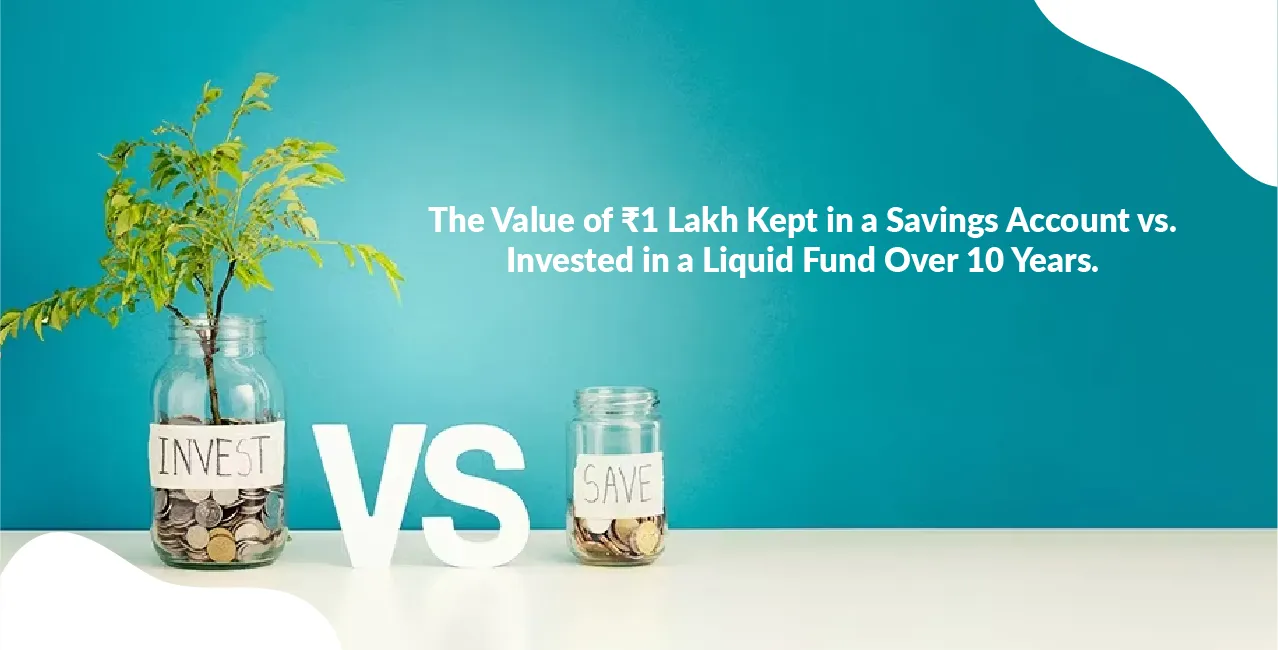
Author
LoansJagat Team
Read Time
5 Min
08 Jul 2025
The Value of ₹1 Lakh Kept in a Savings Account vs. Invested in a Liquid Fund Over 10 Years.
Are you unknowingly losing money by keeping ₹1,00,000 in your savings account?
Most Indians think parking ₹1,00,000 in a savings account is “safe.” But safe doesn’t mean smart. The harsh truth? Inflation eats your money.
And banks aren’t helping either. If you had kept ₹1,00,000 in a savings account 10 years ago, you’d be shocked to see how little it has grown. On the other hand, if that same money were put into a liquid mutual fund, your returns would’ve told a whole different story. Let’s break it down like a financial expert, but in simple Indian English, the kind you and I speak every day.
Why are savings accounts not saving your money?
We love our bank accounts. Most still think a 2.5% return is “better than nothing.” But let’s put that to the test with basic numbers.
Today, top Indian banks offer only 2.5%–2.75% yearly on savings deposits. Even if your ₹1,00,000 sits there for 10 years, the compound returns barely keep up with rising costs of living. Let’s not forget that inflation in India averages about 6%, making these returns meaningless in real value.
Here’s a look at what ₹1,00,000 would become in 10 years if you left it in your savings account earning 2.5% interest:
Savings Account Growth (10 Years at 2.5%)
Yes, ₹1,00,000 becomes just ₹1,28,008. Now, the inflation factor, your ₹1,28,000 is worth less than ₹1,00,000 was 10 years ago. It doesn’t even buy you the same goods anymore.
On top of that, interest from a savings account is taxed as per your income slab. If you’re in the 20% bracket, you're earning even less than 2.5%. After tax, it’s almost like the bank is thanking you for keeping your money there.
Liquid funds: low-risk, better returns, high liquidity
Liquid mutual funds are not as risky as stocks. They invest in debt instruments—like government securities, treasury bills, and commercial papers.
These are short-term and safe. Most people wrongly assume mutual funds are always risky. Liquid funds are made for people who need easy access to their cash but still want more returns than a bank gives.
Liquid Fund Growth (10 Years at 7%)
With liquid funds, your ₹1,00,000 becomes ₹1,96,715 in 10 years. That’s ₹68,000 more than the savings account, just by switching the vehicle. Even after tax, you’re still ahead by a wide margin.
And yes, liquid funds are also redeemable within 1–2 days. You don’t lose out on liquidity either. Many even come with instant withdrawal options up to ₹50,000 per day.
Read More – Best Bank for High-Yield Savings
Savings vs. Liquid Fund over 10 years
Let’s look at both options side by side. Same money. Different outcome.
Direct Comparison
The numbers say it all. By keeping your ₹1,00,000 idle in a savings account, you miss out on ₹68,707 in potential returns. That’s not small money.
Indian mutual funds doing better
There are many Indian liquid funds with consistent 6–7% returns. These are SEBI-regulated, transparent, and often from trusted banks.
Fund Performance (Sample Funds)
Note: These are regular plans, not direct plans. Direct plans have slightly higher returns due to lower expenses.
If someone had chosen one of these funds in 2014, their ₹1,00,000 would be nearly double today. That's the power of compounding.
Also Read - Exploring High-Interest Fixed Deposits
Techniques to make your money work
Here's how experts invest idle money smartly:
- Bucket strategy: Divide your savings into emergency (bank), short-term (liquid), and long-term (equity).
- STP (Systematic Transfer Plan): Gradually shift money from liquid to equity over months.
- Sweep-in FD: This is for those who want the safety of FD but better returns than savings.
- Emergency Fund Strategy: Keep ₹25,000 in the bank and the rest in liquid funds. Withdraw only when needed.
Many top planners follow this pattern to balance returns and access.
Conclusion
If you still think ₹1,00,000 in a savings account is a “smart move,” it’s time to rethink. Yes, it’s safe. But it’s also lazy money. In a world where even milk gets costlier every year, your money should not just sit—it should grow.
The difference between ₹1,28,000 and ₹1,96,000 is not just numbers. It’s better education, health, travel, or even early retirement.
Switching from savings to liquid funds isn’t risky—it’s responsible. And now you have no excuse.
FAQs
1. Is a liquid fund safe for emergency savings?
Yes. It’s low-risk and gives better returns than a bank. You can redeem within 24 hours in most cases.
2. What is the minimum amount to start a liquid fund?
Usually ₹100 or ₹500. Very affordable. You can start SIPs or lump sum, both work fine.
3. Will I lose money in liquid fund?
Only if you withdraw on day of market panic or in extreme events. But 99.9% of times, NAV goes up steadily.
4. How do I withdraw my liquid fund?
You can redeem online via your mutual fund platform or app. Money hits your bank in 1–2 working days.
5. What is the tax on liquid fund returns?
If held less than 3 years, returns are taxed as per income slab. Beyond 3 years, it gets 20% tax with indexation benefit.
Other Related Pages | |||
Why More Indians Are Choosing Gold Loans Over Fixed Deposits in 2025 | |||
About the Author

LoansJagat Team
‘Simplify Finance for Everyone.’ This is the common goal of our team, as we try to explain any topic with relatable examples. From personal to business finance, managing EMIs to becoming debt-free, we do extensive research on each and every parameter, so you don’t have to. Scroll up and have a look at what 15+ years of experience in the BFSI sector looks like.

Quick Apply Loan
Subscribe Now
Related Blog Post


